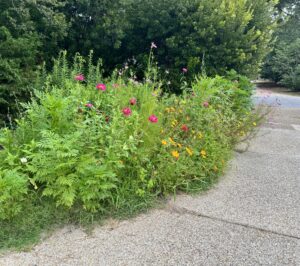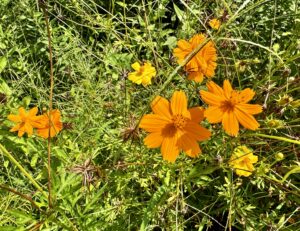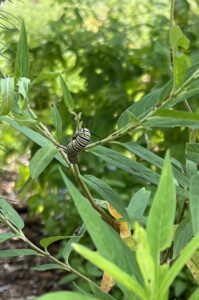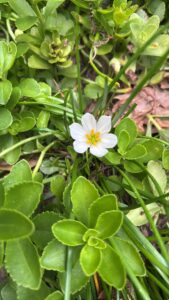
by Mary Reid Barrow
Bob Wells takes a walk through Alanton almost every day and has to put his stopwatch on pause when he reaches Susan Parker’s yard.
Masses of colorful coreopsis and phlox, dainty daisy fleabane, milkweed, buzzing insects and more catch his eyes.
“I can’t go by and not stop and admire all of their native plants and flower beds,” Bob said. “Their yard is always alive, vibrant and constantly changing with the seasons.”
Bob, a LRNow board member, called to make sure we knew about the garden which reminds him of his childhood growing up with First Landing State Park as his backyard.
Turns out Susan’s garden in the center of the circular driveway and around the perimeter too has another connection to LRNow. She began planting it after taking a LRNow Landscape for Life class with Trista Imrich several years ago.
“I got into all this, really, because of you,” Susan said.
After she and husband Andrew moved here from Arlington where they had a small piece of property, she began about four years ago to transform her front yard from grass to flowers, bit by bit.
In another fun connection to LRNow, the orange and yellow coreopsis that brighten one side of her driveway came from a seed packet she got at LRNow’s oyster roast a few years ago!

A few annual zinnias sprinkled among the coreopsis are butterfly magnets too. But in the center of the garden nestled under a river birch is the monarch butterfly’s piece de resistance, swamp milkweed. It’s hard to count the number of monarch caterpillars dining to their heart’s delight on the leaves.

“The neighbors stop and ask, ‘What are you doing in your yard?’” Susan said. “This is the first year it has really come together.”
Susan had her work cut out for her. The yard, almost an acre in size, was all grass with beautiful older trees around the perimeter.
In the back, a swimming pool takes up some of the grassy area and Susan has started carving out small native beds, including one of native rain lilies that lift their little heads after it rains, along with a large vegetable garden to the side. She plans to add additional native trees and shrubs “to create more habitat in the back for birds, fireflies and other creatures.”

“I’m not a patient gardener,” she said. “I see a plant I like and just pop it in the ground, not according to plan, and straighten them out in the spring and fall.
“If you put the right plants in the ground, Mother Nature will provide.”
Susan is a Youth Educator at Norfolk Botanical Garden where she teaches children about the life cycles of butterflies and caterpillars among other topics.
“I tell them, ‘Mother Nature—trust her—she’s got it figured out.’” Susan said. “’We just have to get out of her way.’”
Bob Wells sees Mother Nature’s work in Susan’s “little piece of heaven” every day.
“I wish everyone could experience what I see on my walks,” he said.
